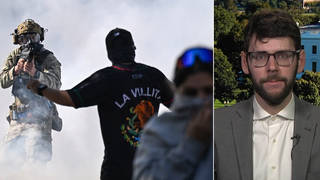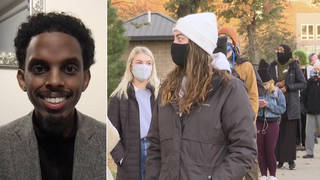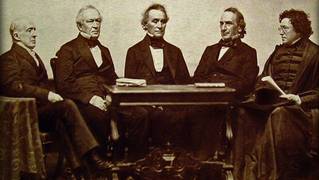
In the final part of our Juneteenth special broadcast, we look at Harvard University’s recent report detailing the school’s extensive ties to slavery and pledged $100 million for a fund for scholars to continue to research the topic. The report documents dozens of prominent people associated with Harvard who enslaved people, including four Harvard presidents. Harvard commissioned the study in 2019 as part of a wave of schools reckoning with their pasts and the ongoing legacy of racial discrimination. “Harvard’s ties to slavery begin with the founding of the institution,” says MIT historian Craig Steven Wilder, author of “Ebony & Ivy: Race, Slavery, and the Troubled History of America’s Universities.” Wilder says that while this history is not new, Harvard worked for decades to erase its complicity in slavery. “We’re really only beginning to reconcile and to really struggle with the deep ties that this institution has to slavery,” he adds.
Transcript
AMY GOODMAN: This is Democracy Now!, democracynow.org, The War and Peace Report. I’m Amy Goodman.
As we continue our Juneteenth special, we turn now to look at Harvard University’s legacy of slavery. The university recently pledged to spend $100 million to redress the school’s deep ties to slavery. The move came after the school issued a 130-page report that revealed at least 41 prominent people connected to the school owned enslaved people. The report states, quote, “Enslaved men and women served Harvard presidents and professors and fed and cared for Harvard students. Moreover, throughout this period and well into the 19th century, the University and its donors benefited from extensive financial ties to slavery,” unquote.
This is an excerpt of a video accompanying the report released by Harvard.
VINCENT BROWN: The evidence of the legacy of slavery at Harvard is in the landscape. You can go to the Old Burying Ground, and you can see the headstones for two enslaved people. One of them, a girl named Cicely, was enslaved to William Brattle, who was a tutor, a treasurer and a fellow at Harvard University.
SVEN BECKERT: We also know that several of Harvard’s presidents who lived in Wadsworth House, which is still standing on campus today, owned enslaved people of African origins — among them, Venus, Bilhah and Juba.
AMY GOODMAN: That’s an excerpt from the video that accompanies the Harvard report. In this clip, Harvard fellow Christopher D.E. Willoughby tells the story of an African teenage boy who was later dissected and studied by a Harvard professor.
CHRISTOPHER D.E. WILLOUGHBY: Sturmann is a particularly tragic figure. He’s only 17 years old. At the end of about six months to a year of being on display, he takes his own life. He hangs himself. But Sturmann’s tragedy doesn’t end with his death. When Sturmann kills himself, they give his body to Harvard.
EVELYNN M. HAMMONDS: Harvard faculty member Jeffries Wyman conducted a dissection of Sturmann’s body. And they also made a set of casts of his body, that remains in the Harvard Peabody Museum collections.
CHRISTOPHER D.E. WILLOUGHBY: His skeleton is turned into a teaching tool. They say it’s left in the care — I mean, “care,” what irony — of professor Louis Agassiz. Sturmann is measured and put in a linear position anatomically between whites and great apes. So, not only is his body being destroyed, he’s also being turned into this point of data to prove his own inferiority.
AMY GOODMAN: That’s an excerpt from the video made by Harvard University as part of a new report documenting the school’s deep ties to slavery, “Harvard & the Legacy of Slavery.”
For more, we turn to MIT history professor Craig Steven Wilder, who has long followed this issue, the author of Ebony & Ivy: Race, Slavery, and the Troubled History of America’s Universities. Democracy Now!'s Nermeen Sheikh and I recently interviewed Wilder. I began by asking him to talk about the significance of Harvard's findings.
CRAIG STEVEN WILDER: I’m happy to be back. And I think it’s been a long road. As you point out, it’s been basically 20 years since Ruth Simmons became the president of Brown University, back in 2003, and media attention turned to the public sort of secret of Brown’s extensive ties to the slave trade. Ruth Simmons, back then, actually commissioned a report, that was eventually published in 2006, the Slavery and Justice Report, that actually laid out Brown’s extensive ties to slavery and the slave trade and came forward with recommendations. We now sit, as you say, you know, 19, 20 years later, and Harvard has come forward with this report. That’s been a long journey.
But the report actually documents an extraordinarily extensive, deep history between the university and slavery that begins at its founding in 1636. Almost immediately, Harvard had an enslaved African on its campus, a man who was simply referred to as “The Moor” and who was used to serve the students. That man likely arrived in Massachusetts on a ship named the Desire. It was the first slave ship to leave New England. It was carrying captive enslaved Pequot Indians into Bermuda and the West Indies, where they were sold for various goods, including Africans.
And so, really, Harvard’s ties to slavery begin with the founding of the institution. And as the report lays out, Harvard depended upon slavery and the slave economy, both in New England but also in the South and the West Indies, for virtually all of its history. Harvard’s history of slavery goes well into the late 19th century.
And I would add that after its ties to slavery end — and they end somewhat involuntarily — Harvard actually then goes to the work of erasing the story of slavery from its past. And so we’re really only beginning to reconcile and to really struggle with the deep ties that this institution has to slavery.
NERMEEN SHAIKH: Professor Wilder, in addition, of course, to this clear complicity between Harvard University and other elite universities to slavery, there was also the question in the report that was raised about Harvard faculty advancing theories of racial difference and eugenics. Could you talk a little bit about that?
CRAIG STEVEN WILDER: You know, one of the sort of striking findings is that in the 19th century, as race science really comes to dominate the academy — it’s the period when science really comes to take over and the modern university gets established, that part of its modernity is its claim to science, its claim to expertise, its claims to a kind of precision in academic research. And the way that that happens is the scientists really turn themselves over to the slave economy. They become, in fact, the chief defenders of slavery, not just at Harvard but at universities across the United States. Race science really sort of thrives.
Louis Agassiz, who’s mentioned in the beginning of your introduction to this, the Harvard race scientist, used enslaved people on a South Carolina plantation for his research. Enslaved people were actually used as research material on colleges and university campuses across the United States. At Dartmouth, which has one of the oldest medical schools, one of the college physicians actually uses the body of an enslaved man. And much like Louis Agassiz, the description that you gave earlier, he takes the body of this enslaved man Cato and skins him. He tans the skin of this enslaved Black man like leather and uses it to dress his instrument case. And then he takes the skeleton of the enslaved Black man and strings it together for instructional purposes.
The beginning of science at the American college and the American university is, in fact, a story of the violent consumption of living and deceased enslaved people.
NERMEEN SHAIKH: Professor Wilder, as you pointed out earlier, the Brown University report appeared in 2006, but it was only in 2019 that the Harvard president said that such research should be conducted at Harvard. Why did it take so long? Like, what kind of pressure led to this?
CRAIG STEVEN WILDER: You know, I always start with Ruth Simmons at Brown, because I think, as the first African American woman — the first woman and the first person of color to head an Ivy League institution, she did a tremendous service in actually getting this story told. The Brown report was a phenomenal document and a transformative moment in the history of higher education.
What’s sort of really quite sad is that in the aftermath of that report in 2006, Brown’s peer institutions were largely silent on the question of their ties to slavery. In fact, most of these institutions simply pretended that this story was unique to Brown alone.
And what happened in the intervening years it that undergraduate students, faculty, graduate students, staff, librarians and archivists at universities and colleges across the United States began doing grassroots work on their institutional ties to slavery. They put up exhibits in libraries. Undergraduates did their senior theses on these topics. And that’s what kept this story alive. My sense is that what has really actually kept us focused on this is the research that thousands and thousands of people have done in courses. For instance, you know, the Harvard project began as a course that got virtually no support, really no support at all from the Harvard administration. Sven Beckert taught that Harvard and slavery class for years, and the administration largely ignored what was happening in that classroom and didn’t want to know what the findings were. That’s also true of the courses that began at Columbia and at Princeton and at Williams College.
And so, really, what’s happened over the last decade or so is that students have really not just produced a lot of the research that we’re now actually beginning to wrestle with, but student activism has actually forced institutions to deal with this history. And I would go back — you know, you can go all the way back to the Occupy movement, to the more recent Black Lives Matter movement, and the decisions, for example, that Georgetown University students made in 2019 — in fact, exactly two years ago — to tax themselves, to impose fees on themselves, in order to begin to pay reparations to the enslaved people who were used to both build Georgetown and fund its first 50 years of existence, and then who were sold in 1838 from Maryland into Louisiana, and the profits from that sale were used to pay off the debts of the college. It was the undergraduates who actually restarted the reparations conversation. It was the undergraduates. It was student activism that brought us back to this moment.
AMY GOODMAN: I wanted to turn to the short film again that premiered along with the launch of the Harvard University report. In this clip, a Harvard professor describes how Harvard Law School was founded.
SVEN BECKERT: In 1736, Antigua’s plantation owners became fearful that enslaved workers were plotting against them, and they decided to crack down.
ANNETTE GORDON-REED: The Royall family was involved in putting down this slave uprising — a lot of head chopping, decapitations, to make people as examples, burning people.
SVEN BECKERT: Then, Isaac Royall Sr. migrated back to New England to his huge property, several hundred acres of land. He brought enslaved workers from the Caribbean to Medford to work. Eventually, Isaac Royall Jr. donates lands to Harvard University, which the university then sells and uses to endow the first professorship of law at Harvard University.
ANNETTE GORDON-REED: And some people take that as the founding of the Harvard Law School.
AMY GOODMAN: Craig Steven Wilder, this is pretty powerful stuff. What we’re talking about here, I mean, it is just a story that some have known in this country, but — and it certainly goes further than Harvard — but the story of Harvard Law School and its connection to the Caribbean slave trade? If you can explain who the Royall family are, and the fact you’ve got this endowed chair, as well, at Harvard Law School named for them?
CRAIG STEVEN WILDER: You know, the Royall family is a family, as the film points out, that traces back to Antigua, an Antiguan plantation family in the 18th century. They removed to Medford, Massachusetts, just outside Cambridge and Boston, later in the century. Isaac Royall Jr., actually, on that farm, that small plantation, had some 60 enslaved people. And that’s the family that eventually actually donates the land that helps to fund and begin the law professorship at Harvard.
I would point out that this is the story, actually, of professional education broadly. Medical schools in the 18th century begin with the dissection and consumption of the bodies of enslaved Black people and often Native Americans. They begin — the very first medical school in North America, which is now at the University of Pennsylvania, then was the College of Philadelphia, begins when the colonial legislature transfers the body of a Black person to the scientists so they can do a public dissection and show, in fact, the new medical arts, display them and display the necessity of them.
Law schools, actually, at Harvard, at Yale, at Columbia have very similar origin stories. They’re actually tied directly into slavery. And law students at Harvard and Yale and Columbia have actually been doing a lot of the research to expose their institutional ties to slavery.
AMY GOODMAN: The new Harvard report doesn’t mention the university is facing a lawsuit from a descendant of two enslaved people named Renty and Delia, who were forced to pose in a photograph by a Harvard professor in 1850. Tamara Lanier filed the lawsuit, saying the university is unfairly profiting from their images. In response to the report, Lanier tweeted, ”STOP GASLIGHTING US HARVARD.” She also tweeted, “If Harvard truly embraced the principles in their report the the Lanier v. Harvard Lawsuit would not be necessary.” We spoke to Tamara Lanier in 2019 about her lawsuit.
TAMARA LANIER: Last week, my attorneys and I filed a claim against Harvard. I’m asking for the return of my enslaved ancestors’ images. And the complaint is more than just a complaint about images. It’s a history lesson. And specifically, it points to the exploitation of slaves and how universities like Harvard continue to profit.
AMY GOODMAN: If you can comment on what Tamara Lanier is calling for and also the recommendations of the report, like working with historically Black colleges and universities, Professor Wilder?
CRAIG STEVEN WILDER: Sure. You know, I think one of the striking elements of the report is the acknowledgment of the length of Harvard’s ties to slavery, which, again, I think you can find something very similar for most of our elite educational institutions. Harvard’s ties to slavery begin, really, with its founding in 1636. But they continue after — after — the end of slavery in Massachusetts, roughly 1783. They continue right up until the Civil War. What’s striking is that even after the Civil War, Harvard continues to have ties to slavery, because slavery still exists in places like Cuba and Brazil, and universities are actively, actually, pursuing those unfree economies as sites for profiteering.
One of the things I had written in my book is that the — in the 18th and 19th century, you could actually judge the value or the prominence of a university by its collection of human remains. Universities and colleges actively collected human beings and samples of human beings. It was part of the evolution of science, and particularly a part of the evolution of the race science that drove the scientific revolution. And so, what’s happening currently in this lawsuit also involves what the report lays out as the thousands of remains of human beings that are currently held in the Harvard museums. Thousands. Most of those remains are likely of Native Americans. They’ve identified, I believe, 15 that are enslaved Africans. One can, again, go by university by university and see the way in which, actually, the 19th century and 18th century legacy of race science continues to play out on our campuses, and we literally live with the bodies of enslaved people and the bodies of Indigenous people who were consumed in the process of building our institutions. Not just in the cemeteries but also in the museums and the libraries, they’re there.
You know, to come to the recommendations, I think the recommendations include a number of things, including, actually, building on the Georgetown example, establishing relationships to descendant communities, Native and of African descent; memorializing and continuing to do research on Harvard’s ties to slavery and the legacy of slavery at Harvard; reaching out to historically Black colleges and universities to establish educational partnerships; really creating a legacy of slavery fund, an endowment, the $100 million to fund all of these promises; and then promising some long-term institutional accountability on these questions.
AMY GOODMAN: MIT history professor Craig Steven Wilder, long followed the issue of slavery, author of Ebony & Ivy: Race, Slavery, and the Troubled History of America’s Universities.
And that does it for our Juneteenth special. Democracy Now! is produced with Renée Feltz, Mike Burke, Deena Guzder, Messiah Rhodes, Nermeen Shaikh, María Taracena, Tami Woronoff, Camille Baker, Charina Nadura, Sam Alcoff, Tey-Marie Astudillo, John Hamilton, Robby Karran, Hany Massoud, Mary Conlon and Juan Carlos Dávila. Our executive director is Julie Crosby. Special thanks to Becca Staley, Jon Randolph, Paul Powell, Mike Di Filippo, Miguel Nogueira, Hugh Gran, Denis Moynihan, David Prude and Dennis McCormick. I’m Amy Goodman. Stay safe.












Media Options